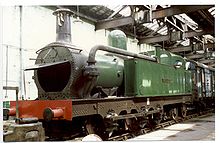- Steam locomotive condensing apparatus
-
A steam locomotive condensing apparatus differs in purpose from the usual closed cycle steam engine condenser, in that its function is primarily either to recover water, or to avoid excessive emissions to the atmosphere, rather than maintaining a vacuum to improve both efficiency and power. It takes the form of a series of pipes, valves and other ancillary equipment usually attached to an otherwise conventional steam locomotive. The apparatus takes the exhaust steam that would normally be lost up the funnel and routes it through a heat exchanger, into the normal water tanks. Installations vary depending on the purpose, design and the type of locomotive to which it is fitted.
Contents
Purpose
Unlike the surface condenser often used on a steam turbine, the condensing apparatus on a steam locomotive does not normally increase the power output. In fact it may reduce it considerably. Whilst more power is potentially available by expanding down to a vacuum, the corresponding low density (high specific volume) implies extremely bulky low pressure cylinders or a turbine would be needed to actually extract it. So with a more practical volume ratio the condenser pressure would be near atmospheric rather than at a more typical low pressure, and the temperature would be correspondingly higher. In exhausting hot steam to the condenser, the temperature gradient between the exhaust steam and the cooling water is greater, so that a smaller heat exchange surface area is needed than would be required for typical stationary or ship-based steam plant of similar power. However none of the energy in the hot steam is available to do mechanical work. The potential improvement in thermal efficiency expected from including the condenser in the cycle is therefore not usually realised within the space constraints of a typical locomotive, indeed losses due to viscous friction in the condenser piping is likely to reduce the power output over what was achievable from simply venting to atmosphere. There are two usual reasons for fitting such equipment, reducing exhaust emissions and increasing range.
Reduced exhaust emissions
Underground railways
 Mersey Railway locomotive, showing the prominent exhaust pipes leading back to the water tanks
Mersey Railway locomotive, showing the prominent exhaust pipes leading back to the water tanks
Originally developed for the Metropolitan Railway to allow their locomotives to work the tunnels of the London Underground. This system was devised by Daniel Gooch and developed by Beyer Peacock. Steam is diverted from the exhaust steam pipes into the water tanks via condensing pipes within the same tanks. The water in the tanks could quickly heat up near boiling point, reducing the condensing effect on the exhaust steam. It was not unknown for the tanks to be emptied and refilled with cold water on a regular basis. Ordinary injectors will not work with hot water (until hot-water injectors were developed) so condensing locomotives were usually fitted with axle-driven boiler feedwater pumps. When not working in tunnels, the steam was directed to the blast pipe and up the funnel in the usual way.
Roadside tramways
In Britain, locomotives working on roadside steam tramways were required by law to have condensers. Water tank condensers (as above) were sometimes used but air-condensers were more common. A steam tram engine usually had a full-length roof and this was surmounted by a nest of air-cooled copper tubes in which the exhaust steam was condensed. Kitson & Co. made many engines of this type. The system was satisfactory for tram engines (which were very low-powered) but would not have worked for larger railway locomotives.
Increased range
Generally this was a more sophisticated installation that used forced air cooling to condense the exhaust steam. The system was intended to reduce the problems of getting enough water to steam locomotives running through desert and very arid areas.
Locomotives fitted with a condensing apparatus
- Metropolitan Railway A Class 4-4-0T
- Metropolitan Railway B Class 4-4-0T
- Great Northern Railway (later LNER) Class N2 0-6-2T
- GWR 9700 Class 0-6-0PT (a variation on the 5700 Class)
- Mersey Railway 0-6-4T No.5 "Cecil Raikes" (preserved at the Museum of Liverpool)
- South African Class 20 2-10-2
- South African Class 25 4-8-4
See also
- Jet condenser
- Surface condenser
External links
Categories:- Locomotive parts
- Steam locomotive technologies
Wikimedia Foundation. 2010.
